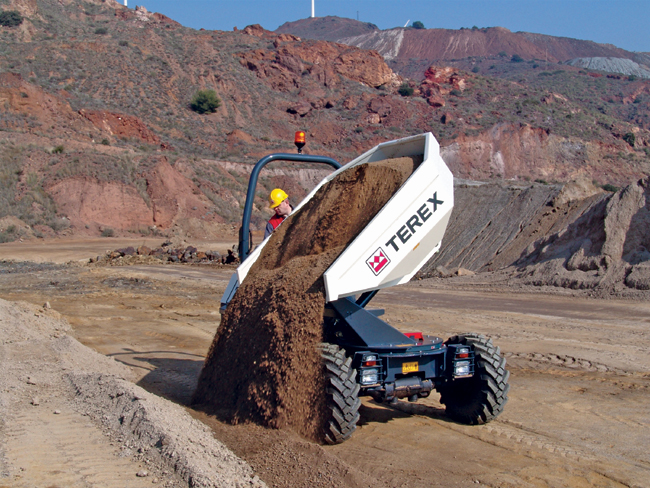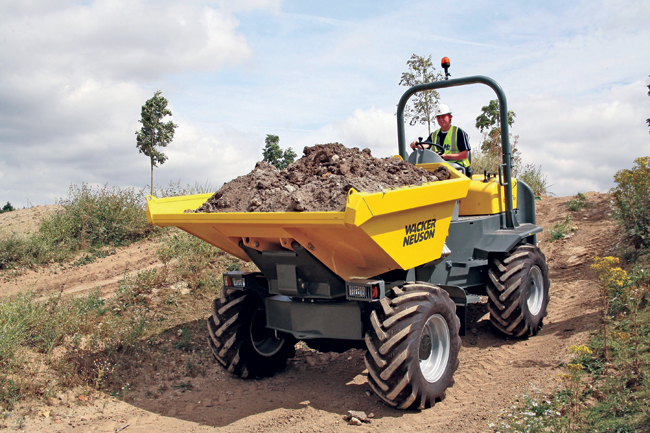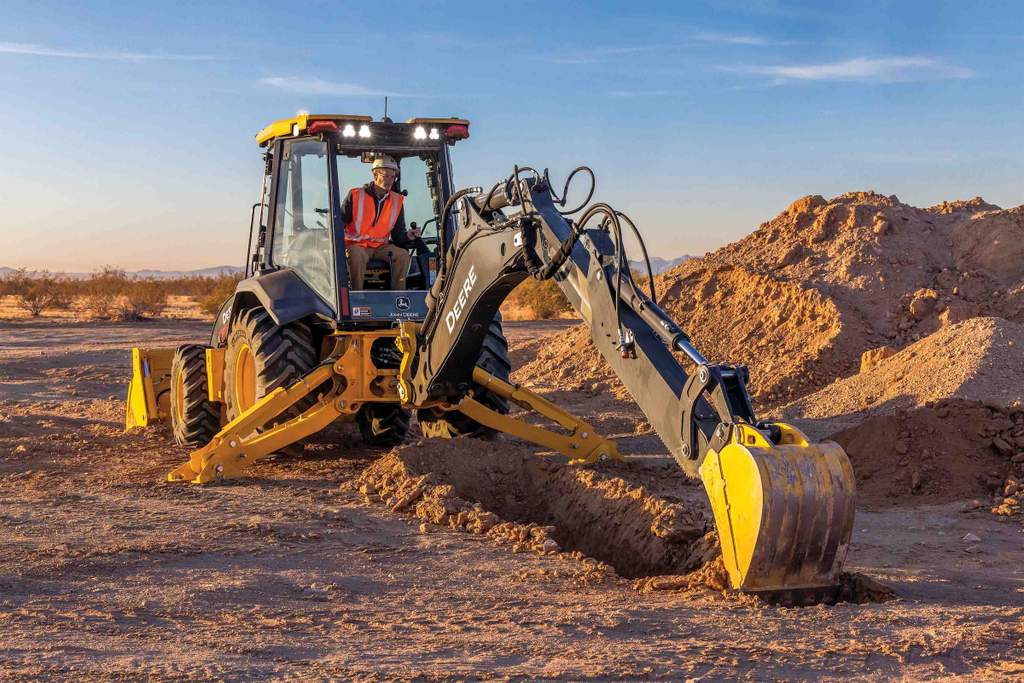Get a Move On
Tight site? No problem. Thanks to their compact size, site dumpers allow crews to maneuver in cramped quarters and are designed to traverse rough terrain. More than a motorized wheelbarrow, site dumpers are essentially a big brother to the power buggy — dedicated haul-and-dump vehicles. And they haul all types of materials, including clay, sand, gravel, spread fill, asphalt, turf and fertilizer, to name a few.

Site dumpers are used on both big and small construction projects, according to Lowell Stout, senior product manager, Terex Construction Americas. In North America, utility contractors have a choice of forward dump or swivel-and-tip models with four-wheel drive and articulating steer capabilities. The multi-purpose power tip, or forward dump, excels at moving materials around restricted worksites.
The side-dump option, or power swivel, enables effective placement of the spoils or load to either side of the machine. The body can swivel through 180 degrees making it very useful for trench backfilling, particularly on small sites and restricted areas. This feature also allows the operator to dump the load while moving forward along the side of the trench.
Terex, for example, currently offers three models of dumpers with the power swivel feature: the TA2S, TA3S and TA6S. The TA2S has a 32.6-hp engine and 1.57-cu yd skip (think: bucket) capacity. The TA3S has 43 hp and a skip capacity of 2.45 cu yds, while the TA6S has 84 hp and a skip capacity of 4.6 cu yds.
Getting the Job Done
Backfilling with a conventional site dumper is fairly straightforward, says Stout. Once the dumper is loaded, it approaches the backfill location perpendicular to the trench and when in position, dumps part or all of its load in the same manner a dump truck would. However, with a site dumper, the operator is facing the load and drives forward to the trench, giving the operator a clear, unobstructed view of the trench unlike a dump truck that would need to be backed into position.
 |
| Precision unloading is key for professional contractors. The side-dump option, or power swivel, enables effective placement of spoils to either side of the dedicated dumper. |
When using a site dumper on a project, says Stout, operators should always be aware of the soil conditions, as well as the surrounding infrastructures and landscapes they are working around — especially when near open pits or trenches. Banks can give way and cave-ins can occur if proper shoring is not in place.
Load capacity and weight distribution concerns are much the same for a site dumper as they are for any hauling or transport vehicle, says Stout. Operators should never carry more material than the published load rating of the vehicle, and when the skip is being dumped, the operator needs to be aware of the center-of-gravity change as the load is being raised so that he is not putting himself and the vehicle in a precarious position.
Small Package, Full-Size Potential
Utility contractors are beginning to realize the cost benefits of employing site dumpers, says Stout. Traditionally, most material movement around jobsites has been done with wheel loaders and skid steers. But, these machines are not designed as dedicated haul vehicles, so they are not as efficient or cost-effective to employ.
For example, loading machines are not able to transfer as much material in one pass as a site dumper can handle, thus reducing cycle times and saving on fuel consumption. Also, during transfer, loading machines will often spill materials and tear up sensitive turf, resulting in costly cleanup and restoration at the end of the project. Because of its light footprint and dump body design, using a site dumper minimizes those costs.
Site dumpers can be easily matched with skid steers or wheel loaders, as well as loader backhoes or excavators, to quickly load jobsite materials for transfer. This significantly reduces material movement cycle times and jobsite cleanup, maximizing production on the jobsite and resulting in a higher return on investment.
Amber Reed is a technical writer for Performance Marketing, based in West Des Moines, Iowa.
Got Dumper Questions?
Wacker Neuson Product Manager of Compact Equipment, Jay A. Baudhuin, Has Answers
Compact Equipment: How are material dumpers categorized?
Jay A. Baudhuin: AEM currently does not track material dumper sales and therefore there is no industry standard to categorize dumpers. The current manufacturers that sell material dumpers in the United States use maximum payload to categorize the dumpers.
CE: What is the load capacity range for dumpers?
Baudhuin: Material dumpers range from 2,200 up to 22,070 lbs in load capacity. Wacker Neuson currently offers the following range of dumpers in the Americas: 2,200- to 13,228-lb load capacity. In Europe, Wacker Neuson offers up to the 22,070-lb load capacity machine.
CE: What benefits do dumpers offer over other material moving machines?
Baudhuin: Dumpers are extremely stable machines that have excellent maneuverability and work well in rough terrain conditions. Also with the swivel buckets, the machine allows for easy and accurate spreading of material even in tight areas. The dumper also allows for more material to be moved at one time than other material moving machines.
CE: What niche applications best suit dumpers?
Baudhuin: Dumpers are well suited for a number of applications. Some unique applications that we have been selling to are nurseries, golf courses, concrete contractors, municipalities and cemeteries.
CE: Where does a dumper fit in on a utility jobsite?
Baudhuin: As a utility contractor begins to dig a trench, he can load the dumper with material instead of setting it by the side of the trench. This prevents having to handle the material twice. Backfilling a trench is extremely convenient with a dumper since the dump bed swivels. You can easily load your fill material into the dumper and drive right up next to the trench, turn the dumper bed toward the trench and drive along the trench dumping the backfill into the trench.
CE: Dumpers are relatively new to the North American market, how are they being received?
Baudhuin: The dumpers have been well received by our dealers and customers. Once contractors use them in their everyday work, they see the endless potential of these machines.
CE: What size is the most popular in North America?
Baudhuin: The 6,600-lb load capacity (3001) machine has been the most popular so far for Wacker Neuson.
 |
| The 6001 (pictured) joins the 1001, 3001 and 1501 models in the growing Wacker Neuson lineup. These versatile off-road machines are ideal for landscape, rental, cemetery and contractor markets. |
CE: What challenges face the dumper on the road to North American acceptance?
Baudhuin: The biggest challenge is getting the contractors on the units to try them. They hesitate, asking why they need such a machine. After a half day of use, contractors quickly find that the machines are very versatile and don’t know how they got along without such a machine.
CE: What options, accessories or attachments are available for a dumper?
Baudhuin: Wacker Neuson has introduced a cab version for the 3001 and 6001 dumper. Other accessories that are available are turf tires, 3-in. seat belt and mirror and lighting kits.
CE: What are a few dumper safety tips?
Baudhuin: The two biggest safety tips are always wear your seat belt when running the machine and to have the operator get off of the machine when filling the dumper.
CE: What is the price range for a dumper?
Baudhuin: The dumpers range in price from $24,000 to $55,000, depending on the size and accessories.





Comments are closed here.